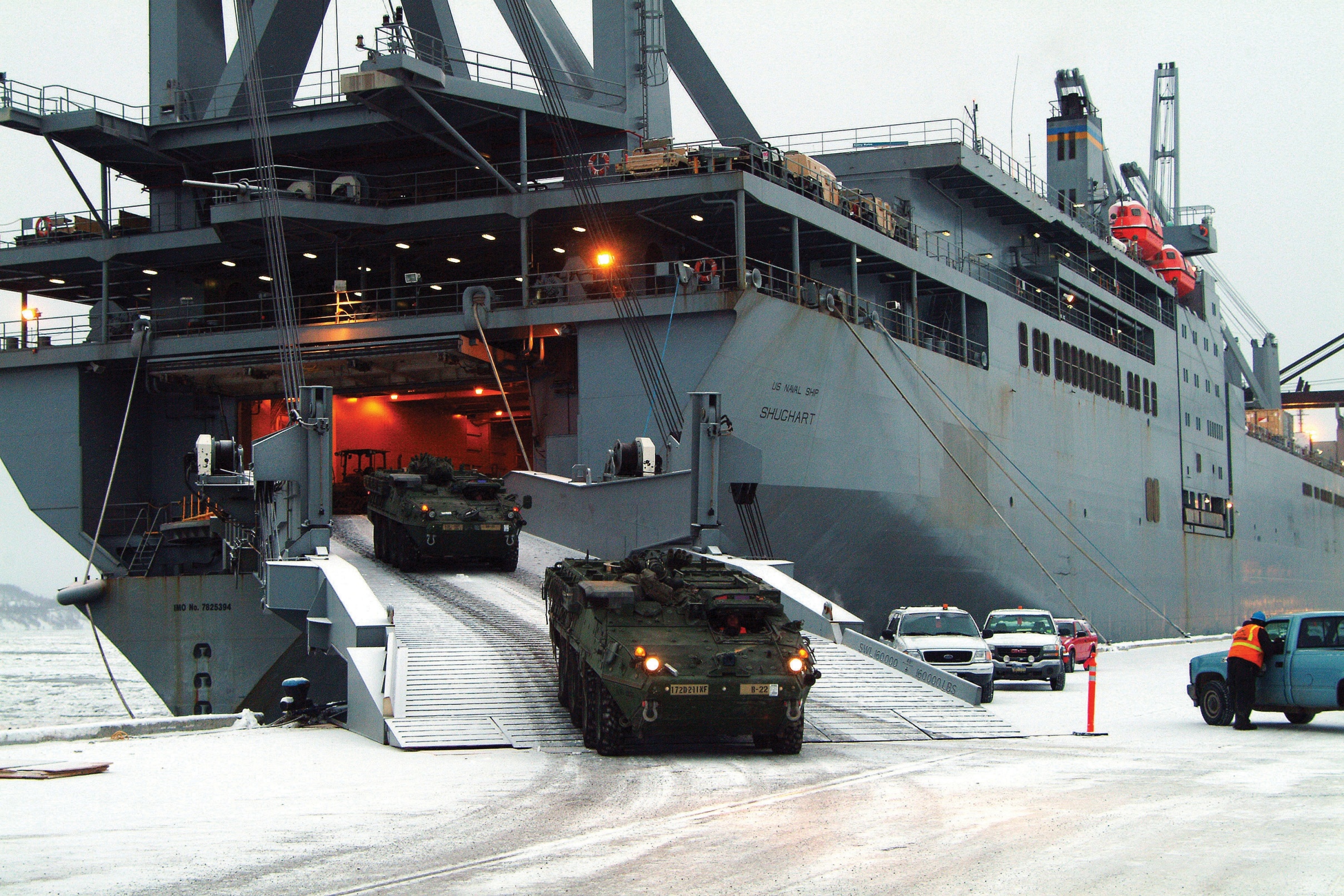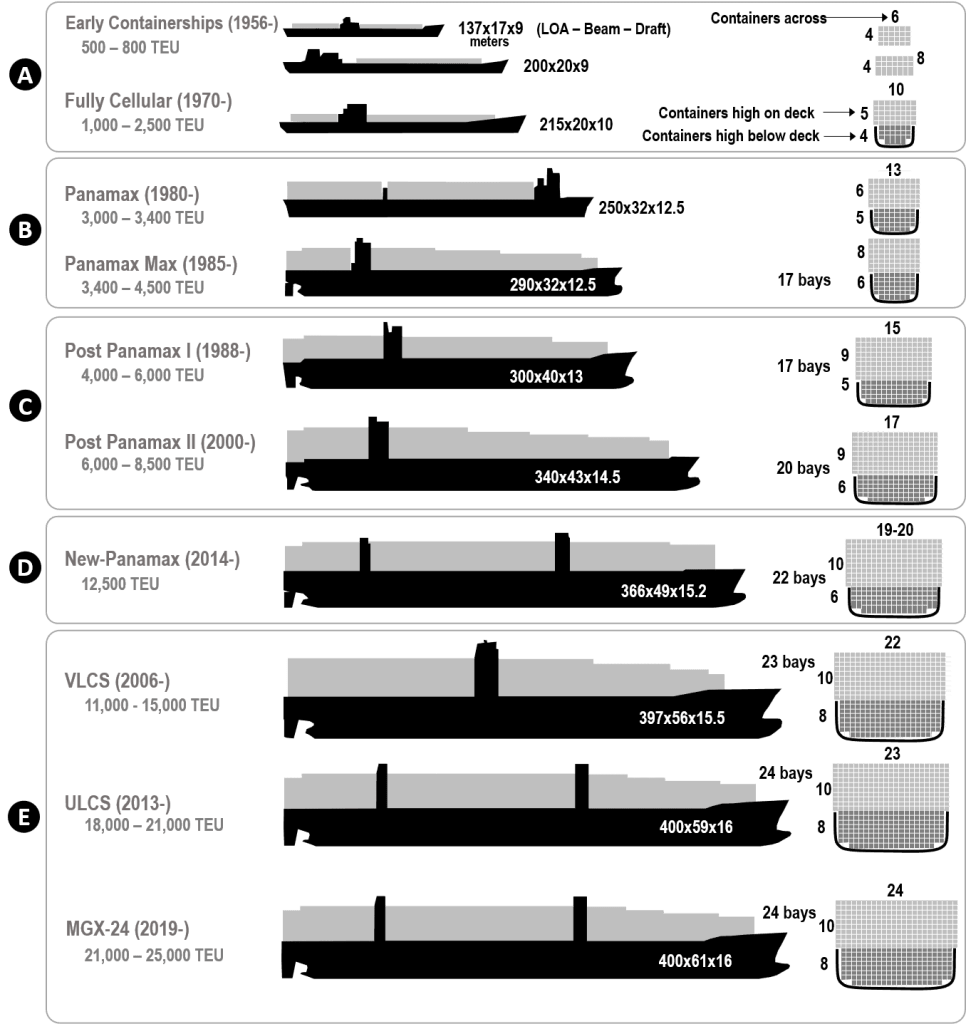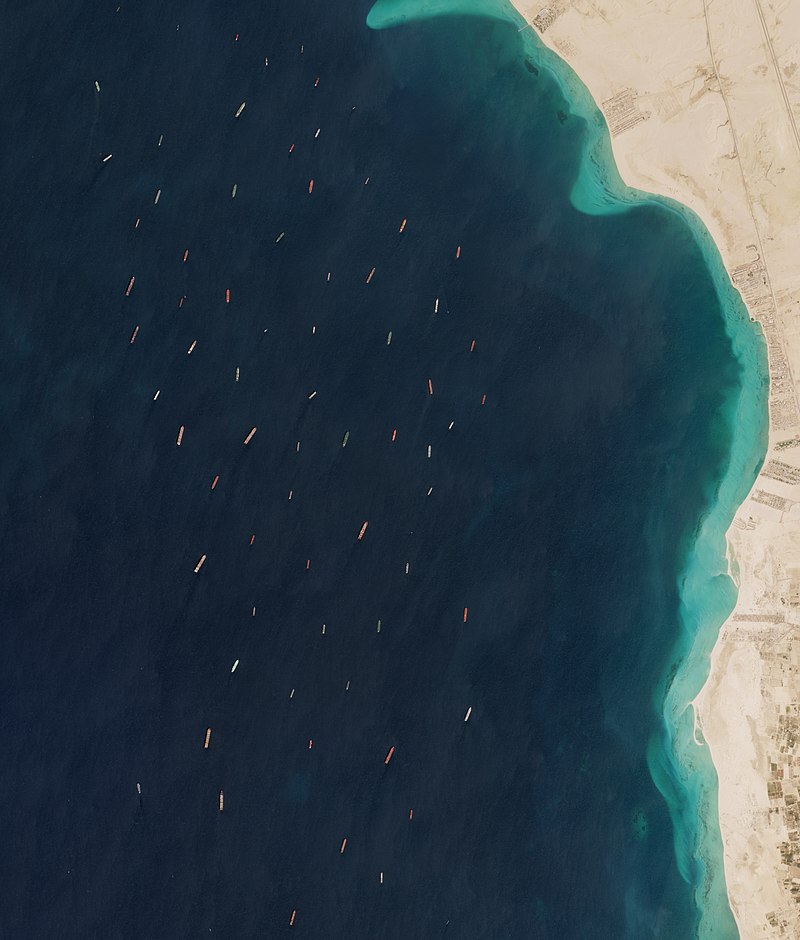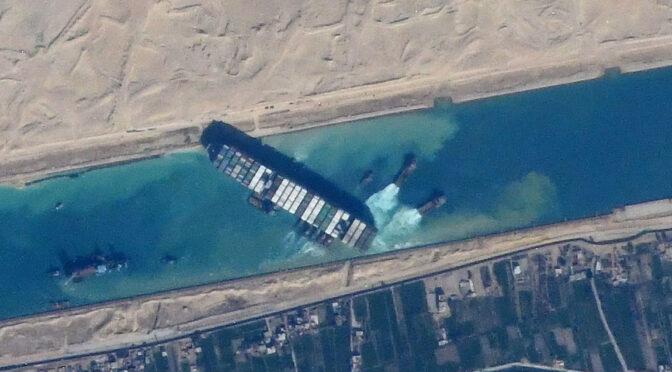Maritime Infrastructure and Trade Topic Week
By Dr. Salvatore R. Mercogliano
The grounding of MV Ever Given from March 23 to March 29, 2021 captured the world’s attention. Many people asked, how could such a modern and large vessel find itself with its bow rammed into Asia, its stern aground on Africa, and its midship astride one of the major maritime chokepoints in the world? The world was also entertained with thousands of images from the little digger scratching away at the sand along the ship’s bow, to a representation of Austin Powers trying to dislodge Ever Given from a tunnel. Amidst all of this, ships traveling between Europe and Asia piled up in the anchorages off Port Said and Suez, hoping that the Suez Canal Authority, and eventually SMIT Salvage, could clear the containership and allow a resumption of normal trade. Her removal after six days opened the floodgate of vessels looking to traverse the canal and resume the international flow of goods and allow military vessels – such as the USS Dwight D. Eisenhower carrier strike group – to perform their missions. But behind the veneer of memes and jokes the grounding of Ever Given exposed the fragile nature of global trade and the maritime infrastructure that supports it.
The Ever-Growing Containership
One of the many questions asked following the event concerned the size of Ever Given. At 1,300 feet in length, 200 feet across, drawing nearly 48 feet of water, with a deadweight capacity of 200,000 tons, and capable of carrying 20,000 twenty-foot equivalent units (TEUs), she is one of the largest ships in the world. Part of a new generation of Ultra Large Container Ships (ULCSs), these behemoths were ushered into the world when Maersk Lines introduced their new Triple E-class in 2011. Touted for their Economy of Scale, Energy Efficiency, and Environmentally improved, the ships were 1,309 feet long and 193 feet wide, and they could not transit the Panama Canal – including the new lane opened in 2016. They were capable of speeds of 22 knots and could carry 18,000 containers. By comparison, when the first containership, SS Ideal X, was introduced in 1956 by Malcolm McLean, she could only carry 58 boxes. A little over a half a century later, this had expanded over 300-fold. This was necessary as world maritime trade boomed from 880 million tons in 1956 to 8,775 million tons in 2011. Today it peaks at over 11 billion tons daily.
Container ships not only carried more cargo, but they improved all aspects of the process, from loading, to movement via truck or rail, to ports, stowage aboard ships, offloading, and transportation to the consignee. During World War II, an American Liberty ship had the ability to transport 10,000 tons of cargo. It would take days, or even weeks, to individually load, block and brace individual cargo within the holds of the ships. Sailing at a speed of 11.5 knots, once they arrived, it took nearly as much time to unblock and unstow the cargo. The Triple Es could move twenty times the cargo, faster and more efficiently with a fraction of the crew. It is difficult to definitively answer the question if the ULCSs were built to support the increase in world trade, or if the ULCSs facilitated the growth themselves.
Prior to the Triple Es, McLean, and his company Sea Land, along with Maersk, continually pushed the envelope of containership construction. In 1972, McLean introduced the SL-7s, which at 33 knots were the fastest cargo ships in the world. Unfortunately, the timing for their operation coincided with the OPEC embargo and the skyrocketing cost of fuel. This ultimately led to Sea Land selling the ships to the U.S. Navy for conversion into Fast Sealift Ships. Today the eight ships, approaching their 50th anniversary, remain as elements of the aging Maritime Administration Ready Reserve Force. Maersk adopted a more conservative approach to speed and focused on carrying capacity with the introduction of their L-class in 1980. At 24 knots and able to carry 3,400 containers, almost three times that of the SL-7s, the Ls marked the first of several innovative jumps in containership size over the next few decades. Ironically, the L-class would also end up with the U.S. Navy after the Persian Gulf War when converted into the Shughart-class roll-on/roll-off ship for the Military Sealift Command.

Concurrently, McLean, then at the helm of United States Lines in the early 1980s built a dozen large vessels intended to inaugurate an around-the-world service. Capable of carrying 4,258 boxes, the Econships built by Daewoo in Korea were the flagships of the American merchant marine, but suffered from one serious shortfall. Learning his lesson from the SL-7, McLean opted for fuel efficiency and carrying capacity over speed. The ships were agonizingly slow at 16 knots. A new competitor, Evergreen Marine, appeared on the scene and offered a similar around-the-world service, with both east and westbound service, and faster vessels. This tradeoff between cargo capacity and speed could only be overcome by increasing the overall size of the vessel. Maersk accomplished this by introducing the R-class in the early-1990s (6,000 TEUs), the S-class in the late-1990s (8,000 TEUs), the E-class in the mid-2000s (12,500 TEUs) and then the Triple Es in the early 2010s (18,000).
The roll out of the Triple Es was a master performance by Maersk. They invited the world’s maritime press and influencers to Korea for the launch of Maersk McKinney Moller. Concurrently, the Discovery Channel developed a multi-episode series on the vessel. Maersk even had fellow Danish company Lego unveil a set featuring the vessel. The construction of the 20 vessels also highlighted another vital aspect of world maritime infrastructure: shipyards.
When Malcolm McLean built his SL-7s, he went overseas to Germany and the Netherlands since he did not want to be constrained by construction and differential subsidies available under the Merchant Marine Act of 1936. Similarly, he built the Econoships in Korea. Most Maersk ships were built in their own yard in Denmark, Odense Steel Shipyard, but following the global recession of 2008, Maersk closed the facility. In February 2011, Maersk contracted with Daewoo Shipbuilding and Marine Engineering to build 10 ships for $1.9 billion. A few months later, in June, they exercised an option for an additional 10 for a similar price. Maersk McKinney Moller was handed over to the company from Daewoo on July 2, 2013. The last of the twenty, Mathilde Maersk, followed on June 30, 2015. A total of 20 ships were launched in two years and four months, a mindboggling delivery schedule.
A look at a list of the ULCSs reveals that they follow the trend of world ship construction today where over 90 percent of all commercial ships are built in either Japan, the Republic of Korea, or the People’s Republic of China. Except for the Philippines, with about four percent, the remaining six percent is spread around the world with no other nation having a single percentage of construction. In many ways, the demise of commercial shipping in the United States and across Europe, along with the economic recession of 2008, and the need to further expand on the size of ships like the Triple Es, promoted the shipbuilding race between these three East Asian countries. Like the dreadnought race of the early twentieth century, these three nations are aligning their shipyards into larger entities to outbid, outproduce, and outlast those of their neighbors.

As the vessels continue to grow, the infrastructure to support them must adjust to accommodate them. Along the East Coast of the United States, cities and states undertook massive dredging projects to allow entry of these larger containerships, but not the ULCSs as they could not navigate the new lane of the Panama Canal. This required dredging down to 50 feet and in the case of New Jersey, raising the height of the Bayonne Bridge to permit vessels to pass underneath. That cost was borne by the citizens of those communities for ships registered and owned overseas and cargo being distributed throughout the nation. The chasing of infrastructure goals may have been what caught up with Ever Given in the Suez on March 23.
As the ship headed north that morning in the lower section of the Suez, her size and dimensions provided little clearance with the bank and bottom. Sailing at a high rate of speed, almost 13 knots, the ship could have experienced squatting where the stern sinks down lower in shallow water at speed. Additionally, if she came too close to one of the banks, suction could have pushed off the bow, while sucking in the stern. The reports of high winds that day would have been an issue with a surface area equivalent to a 14-story building a quarter of a mile long. Other factors, such as the introduction of new Very Low Sulfur Diesel fuel in 2020 has caused engineering issues in many vessels and could have contributed to a potential engine casualty. Plus, there is always the possibility of pure human error that may have contributed to the closing of the canal for almost a week.
Broader Implications
Regardless of the cause, the closing of the canal marked an important event not just in the world economy but the shipment and protection of trade. While the event was over quickly, a long-term closure, such as what happened during the Suez Crisis or the Six Days War, would have global ramifications. The vulnerability of the chokepoint to an accident, and now the efforts by the Egyptians to extract $916 million from Evergreen for the event, may cause companies and nations to reconsider their use of the canal. One nation looking at the incident in a positive light is Russia. Their attempts to entice cargo into the Arctic and utilize the Northeast Passage may now appear a more viable solution, although some firms, such as MSC, indicate they are not interested.
For China, their concern over the closing of their sea lanes of communication has been the paramount reason for the growth of the PLA Navy and their efforts to develop bases in the South China Sea and Indian Ocean, astride their major trade routes. Taking the writings of Alfred Thayer Mahan literally, they realize that the role of the military is to support their economic endeavors, protect the supply of raw materials – such as bulk material from South America, Africa, and Australia – and exports of their finished products.
It is noteworthy that while China has appeared to have learned this lesson from history and the recent past, the United States fails to heed this concern. America lags in infrastructure, as the repeated announcements by presidents of infrastructure bills and programs indicate. The current backlog of containerships off the West Coast, particularly the ports of Los Angeles and Long Beach are not so much an issue with the ports but the ability to get the cargo off the terminals via road and rail and into the interior of the United States – which was the precise issue that Malcolm McLean attempted to alleviate with the advent of containerization in the 1950s.

However, today the infrastructure and trade of the United States is in peril. Failure to incorporate the commercial maritime sector into national defense planning documents and provide visible and vocal support is undercutting the industry. Ships that make up the afloat prepositioning force, the surge sealift, and the domestic Jones Act fleet need replacement as they are aging. Investment into national shipbuilding would have an impact on military vessel construction by employing more workers into this industry instead of the boom-and-bust cycle which requires repeated training and loss of experience. An examination of Chinese shipyards reveals commercial ships being built alongside new frigates, destroyers, and aircraft carriers.
It is strange to see the world’s fleets building vessels larger than Ford-class carriers and competing in trade that at one time was being battled over by national fleets. Today, international corporations, with ships flying the flags of open registries, dominate the world’s oceans but with little means of protection. This is readily apparent to the Indian crew, onboard the Taiwan-based Evergreen vessel, managed by a German firm, with an American classification society, owned by a Japanese company, with insurance in Great Britain, and trapped in Egyptian waters. That is the situation facing world trade and maritime infrastructure today that is largely absent from most military and naval discussions but essential to the world’s economy and the military’s logistics. Failure to invest in domestic infrastructure and trade will place nations at the mercy of forces beyond their control. While that may be sufficient for many nations, any country wishing to be considered a sea power should heed the words of Mahan, as recently recapped by Andrew Lambert in “What is a Navy For?” and consider, “What is a Merchant Marine For?”
Salvatore R. Mercogliano is a former merchant mariner, having sailed and worked ashore for the Military Sealift Command. He is an associate professor of history at Campbell University and an adjunct professor at the U.S. Merchant Marine Academy. He has written on U.S. Merchant Marine history and policy, including his book, Fourth Arm of Defense: Sealift and Maritime Logistics in the Vietnam War, and won 2nd Place in the 2019 Chief of Naval Operations History Essay Contest with his submission, “Suppose There Was a War and the Merchant Marine Did Not Come?”
Featured Image: The containership Ever Given stuck in the Suez Canal in Egypt, viewed from the International Space Station. (Photo via Wikimedia Commons)


From one Mariner to another Mariner. I want to shake your hand for a brilliant article. If only ship owners ship builders and the Mercantile Mariner agree to hazards and difficulties in ship handling in confined waterways. My sole prayer is there is always sufficient water under your keel Dear Captain